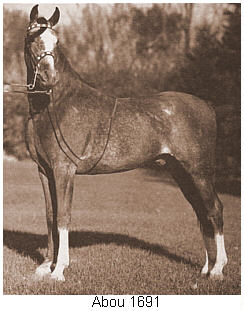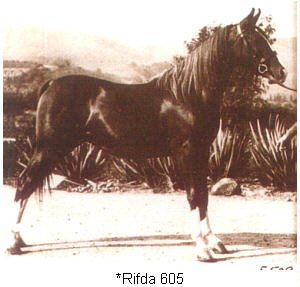No more Nureddin II descendants left
Nureddin II was born in 1911 at Crabbet Park in the UK. He was reported to have been sired by Rijm out of Narguileh, and thus a full brother to Nasik. He was bought by Roger Selby and exported to the USA in 1933. He was a big horse, measuring a full 16 hands, but again his recorded sire Rijm was just a trifle shorter at 15.3 hands.

Nureddin II is not an Al Khamsa horse, even though both of his recorded parents are. It was said that Carl Raswan, the father of purist Arabian horse breeding in the USA, had access to information according to which Nureddin II’s dam Narguileh was bred to an English Thouroughbred stallion at Crabbet and that the resulting foal was Nureddin II. As a result, Nureddin II was not included as “Blue List” in Jane Ott’s Blue Arabian Horse Catalog, on which Raswan was a major influence, and a special “sublist” was created for him and his otherwise “Blue List” descendants: these horses were subsequently known as “sublist Nureddin”. Miss Ott actually encouraged breeders who were interested in preserving Nureddin’s type — which was a key component of the ‘Wentworth Superhorse’ bred at Crabbet during Lady Wentworth’s tenure — to preserve these horses, and was already warning about their possible extinction if nothing was done about them.
The first Al Khamsa roster (the list of horses accepted by Al Khamsa) was grandfathered from the Blue Catalog in 1976, and Nureddin II was not included in the roster. Other horses which had been sublisted by Miss Ott, such as Dwarka and Basilisk, were accepted by Al Khamsa, but Nureddin II wasn’t. By then, Raswan’s assertions had been thoroughly examined and, at least in my personal opinion, successfully disproved by a number of people like the late Billy Sheets, but many within Al Khamsa felt there was still not enough positive evidence to accept the horse. Nureddin II was proposed several times for inclusion in the Al Khamsa Roster, last in 2001, but his proposal always failed to gather enough votes to pass. This horse’s case was certainly one of the more painful and grueling ones that Al Khamsa had to deal with over the years.

All this to say that today Miss Ott’s prophecy is pretty much realized, and there are no Nureddin II descendants that are otherwise Al Khamsa-eligible left. The last ones traced to the mare Laida (Abou photo above x Il Id Ilkbir by Farana), a ‘Ubayyah Sharrakiyah whose addition to Al Khamsa would have perhaps helped preserve the now extinct line of the desert-bred mare *Abeyah, which Homer Davenport imported from Arabia in 1906. Laida had a line to Nureddin II, through his maternal grand-dam Rifda (photo below) who was a daughter of his.

Laida produced several otherwise Al Khamsa eligible horses for the Atkinsons of Anchor Hill, including the mares Fa Latribi (by Al Metrabbi), and Anchor Hill Haida (by Hadbah), who in turn produced the 1972 mare Anchor Hill Aida (also by Al Metrabbi). The latter produced two otherwise Al Khamsa eligible stallions, Rocky Ridge Moraf (by Ibn Morafic) and Rocky Ridge Erafi, but none of them looks like he’s been replaced. Laida also produced the two stallions Anchor Hill Haid and Anchor Hill Habou, both by Hadbah and both of which left a large number of offspring. A quick look, which needs to be confirmed more thoroughly at their offspring the Arabian Horse Association’s Datasource tells me none has left otherwise Al Khamsa offpring. So there’s the end of that.
[Dec. 2 update: here is a picture of Nureddin’II full brother Nasik — notice the resemblance between the two, with a link to short article about him by Michael Bowling:

Interesting Edouard and I am glad that you feel that Nureddin II is OK as my lovely (and yes big… 15.2 1/2hh !) 6yo gelding traces to him in several lines!
He is very ‘typey’ (horrible word) in appearance and action, no trace of TB!
Another of mine traces to Dwarka …please, what is his provenance because the little that I have read seems to be fairly thin evidence that he was certainly Asil, I was surprised that he is accepted by Al Khamsa there must be more than I know of??
Thanks, what is more thankyou for your efforts in keeping up such a fascinating blog… even for a non Asil owner such as myself it is a mine of information that I am enjoying digging through!
Lisa
There is nothing more on Dwarka that you would not know already Lisa, that is, the info from the UK studbook. There was a leap of faith there, IMO.
I once covered a mare by Shamel a Kuhailan al Rabda(Basil x Shahnaz) standing at the Syrian National Stud ,Shamel measuring 1.63m or 16 hands.
“Big” Asil Arabs are not uncommun one cant find them in Mesopotamia fertile lands,they were known in the West as “Mesopotamia horses” (Both Basil and Shahnaz were Shammar horses) General el Haddad bought some of them in behalf of Babolna during his Iraqi trip 1902/1903.
Less common is Bedouins selling such mares.
Anyhow “Nurredin”II does not look as an Anglo Arab at all.
Joe: you’re right, while his head is a bit plainer than many Asils, his legs show bone size large enough in comparison to his body size to rule out Thoroughbred blood, at least close up. The former commander of the Hungarian State Alsozuk(sp) stud farm, Lazlo Monastory remarked on several occasions that the thing he had to watch out for in breeding Anglo- Arabs was the loss of bone compared to how much the body size increased in the first crosses.Yet Rifda and Abou both show commendable substance along with good strong couplings as well.
Best wishes
Bruce Peek
Thank you all very much for your thoughts on this assertion that Nureddin ll was possibly not purebred Arabian. I appreciate your input on this very much. Interesting site as always!
How tall was *Nureddin II? An article in the British Live Stock Journal for January 7, 1921 describes him as 15.2 hh. According to the Selby Stud catalog, he was “Nearly 16 hands.” The 1924 Crabbet Stud catalog says “nearly 16 hands.” Lady Wentworth’s description of him in Crabbet herd book records however says 15.3 hands.
To add to the mix of that question, there is also an advertisement for Nureddin II standing at stud that ran in a 1919 issue of The Live Stock Journal (Vol 89) under the ownership of S. G. Hough that states he was “15h.1in.”
From the old Pathe movie of a Crabbet stallion parade, he looks to be tall, but also very scop-ey with a long neck, and would look even taller than he was, just in overall impression.
how tall were Rijm and *Nureddin’s full brother *Nasik?
If I recall correctly, and RJ and Michael can jump in here anytime!, Rijm was actually taller than *Nureddin II, but he has a notably tall wither. *Nasik was supposed to be c15.1, I think. You can see, standing next to Lady Wentworth (who was tall), he looks more like 14.2 or so to me.
The 1924 Crabbet Stud catalog says *Nasik was 15.1.
The Crabbet herd book says Rijm was measured at 15.1 1/2 in 1905, when he was only 4 years old, and so I would consider that a minimum height.
Lady Anne Lytton stated in her article “Memories of the Crabbet Stud” that Rijm was 15.3 when fully mature.